|
Flora and Fauna associated with Kedron Brook are described below. Further detail on the Fauna Habitat occurring along Kedron Brook is in the report 'An Assessment of the Fauna Habitat along Kedron Brook'. A pdf file that may be downloaded from this site. Remnant ecosystems along Kedron BrookRiparian forestEucalypt open forests and woodlands Paperbark forests Littoral riparian forests Mangrove ecosystems Grassland Modified and managed habitatParklandsChannels Abandoned land Fauna habitat in Kedron BrookInvertebratesFish Amphibians Reptiles Mammals Birds Remnant ecosystems along Kedron BrookThe following descriptions provide an overview of vegetation types (ecosystems) readily identifiable along Kedron Brook. All types can intergrade with one another and can vary in composition, structure and naturalness. More detailed vegetation types may be identified with detailed field observation. Remnants along Kedron Brook often have some vegetation components (i.e. understorey, canopy, herbaceous species) altered or removed. Riparian forest |
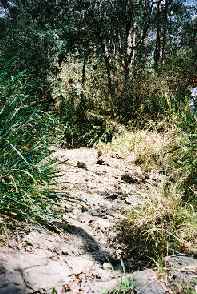 |
Riparian forest may have a sparse or a more dense (closed) forest canopy. Sparse riparian canopies contain trees such as ti-tree and paperbark; the understorey has a variety of grasses, sedges and Matrush (Lomandra spp). The canopy may be continuous and connected across the steam but doesn’t densely shade the streambed. A closed riparian canopy shades the stream channel. Along middle and upper reaches of Kedron Brook, Waterhousia floribunda is a common native species contributing to these canopies. Occasionally River oak (Casuarina torulosa) and paperbarks (Melaleuca quinquenervia) are present. In the past, this vegetation would have contained a diversity of native trees. Currently, camphor laurel (Cinnamomum camphora) and exotic celtis (Celtis sinensis) contribute to the tree canopy. The understorey is variable yet sparse; ferns, grasses and herbs would have been common in natural areas but in the remnants Lomandra and introduced grasses dominate the understorey. |
|
In the channelised sections of Kedron Brook, a distinct assemblage of plants has developed in response to the channel formation and the on-going management imposed. The sandy channel supports a range of native and introduced emergent aquatic plants. Conspicuous is the native bulrush (Typha orientalis) but other native species include Lepironia articulata and Juncus usitatus. Para grass (Bracharia mutica) is widespread along the channels and forms dense swaths in sections of Kedron Brook. Natural channels still remain in the vicinity of Grange Forest Park and along the Keperra and Mitchelton reaches. |
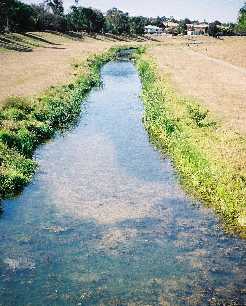 |
|
Butterflies can be readily recognised and there is considerable knowledge of the biology and resource requirements for many species. By providing resources for butterflies, they can be encouraged to an area and increase in numbers. Butterflies require suitable larval food plants, food for adults (flower nectar and other plant juices) and water for adults. Butterflies can be specific in the types of plants on which they lay eggs. The plant must provide food for the larvae when they hatch and protection during pupation. Larval food plants may be quite different from the plants required by an adult butterfly that feeds on nectar and sap. Different butterflies have different requirements. Generally a diversity of flowering native tree, shrub, grass, vine and herb plants will increase the diversity of butterflies able to use an area Some butterflies have become rare in South-east Queensland due to loss of habitat. Butterflies are able to utilise both the Kedron Brook environs and nearby urban gardens. In urban gardens pesticides applied to fruit trees and garden plants will harm butterflies or their larva. Native shrubby and herbaceous plants used by butterflies have been replaced by exotic flower gardens and weeds. Generalist butterflies can use these plants but the resources available to more specialised native species are limited. |
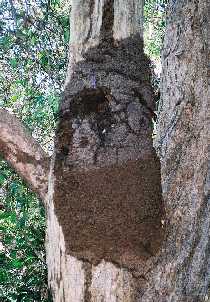 |
|
FishMany of the small fish in Kedron Brook are introduced. The Gambusia or Mosquito fish was observed in all reaches of Kedron Brook and was released many years ago. Aquarium fish (guppies, platys and swordtails) are common in the middle reaches of Kedron Brook. Notwithstanding this, native Gudgeons, Crimson – spotted rainbow fish, Olive perchlet and Pacific blue eyes have been reported from Kedron Brook. Larger species of native fish are common along permanent flowing parts of Kedron Brook. Silver perch swim in small schools close to the surface; they are particularly active in warmer months when there is some flow in Kedron Brook. In spring the male jewfish or eel-tailed catfish builds nests in the sandy shallows by swimming round in circles to form a circular depression. Once the female has laid her eggs, the male guards the nest for up to 3 weeks. On hatching, juveniles hide in aquatic vegetation. The larger fish probably survive in Kedron Brook because they are too large to be bothered by the aquarium species. To date, Kedron Brook appears free of carp and other larger introduced fish that could jeopardize the survival of the larger native fish. Fish most likely to survive in Kedron Brook are those able to utilise a number of habitats, adapt to change and tolerate the fluctuating pollution and nutrient levels. AmphibiansA decline in frog populations around the world was noted in the 1970’s. In some cases habitat loss has caused decline, in other areas the reasons for this decline are less well known. Frogs inhabit different types of habitat; tree frogs, marsh or sedge frogs, and burrowing frogs all occur in the vicinity of Kedron Brook. The utilisation of breeding areas by the different groups is not distinct, different species (from different groups) will use the same breeding pond or habitat. Frogs tend to be opportunistic – they breed when there is sufficient water and it is at a temperature that stimulates their calling and therefore mating. Permanent ponds are not necessarily required, species will utilise pools of standing water on playing fields, in parkland and in intermittent drains. Breeding is successful in these locations if there is sufficient time for the tadpoles to develop before the water body dries up. This is then a balance between providing adequate (warm) water temperatures to facilitate rapid frog development and protection of the waterbody from predators that would make a quick meal of emerging froglets.
Frogs can breed in unlikely locations; many species will breed in inconspicuous areas unnoticed by human visitors. The presence of introduced fish and competition with cane toad tadpoles limits frog breeding in the Kedron Brook channel. Cane toads tend to “jump the gun” on native frogs by breeding earlier in the season, often in response to light rainfall which did not stimulate mating calls in native species. Cane toads are a tough and adaptable species; toad tadpoles are able to use concreted drains and other modified structures to breed and develop. ReptilesThe specific requirements of many reptiles and their actual distribution along Kedron Brook are poorly known. Some species are common and often seen (Eastern water dragon, Water skinks), others are smaller or more cryptic (prefer to hide) and therefore their distribution is unknown but they may be quite common along Kedron Brook. Because most reptiles are ground-dwelling, they are vulnerable to predation and death on roads. This problem is compounded by the tendency of species to “sun” themselves in early spring on the warm bitumen of roads. As a lot of the reptiles, particularly skinks and smaller lizards, have a relatively small home range they are able to reside in small pockets of habitat retained in the vicinity of Kedron Brook and in urban yards. For some of the smaller species the trunk of a mature eucalypt may provide an adequate home range. Reptiles are often ground dwelling and may burrow, shelter under rocks, stones and logs, use hollows in trees or hide under the bark of trees. Many are insect feeders and will congregate where insects are plentiful (i.e. near the stream). Larger reptiles tend to be omnivorous (eat plants and animals). Dragons and water skinks are abundant along the length of Kedron Brook. They can often be seen resting in sunny locations on rocks or upper banks of the stream and are quick to retreat to the waters edge or cover of thick vegetation when disturbed. Keelback snakes are also relatively common. An absence of ground cover such as fallen timber, leaf litter and nesting hollows probably limits the distribution of reptiles in parklands. Disturbance by dogs and cats may prevent nesting. Roadways prevent movement from one habitat to another in urban areas. Despite these conditions, skinks are plentiful in areas with a ground covering of leaf mulch or fallen timber. Turtles are common in deeper reaches and in pools along Kedron Brook. The saw-shelled turtle is the most commonly sighted, although the Brisbane long-neck turtle has been reported from Kedron Brook. MammalsMammals have become severely restricted in distribution in urban areas. Wallabies and kangaroos have disappeared from most of the area; road kills have contributed to this. Bandicoots survive in some of the larger open forest remnants. They are evident by their diggings, shallow triangular scrapings on the soil surface. The Long-nosed bandicoot is common in the Sparkes Hill Reserve and upstream in forest remnants, where they are active at night and shelter under lantana thicket during the day Larger mammals such as wallabies are present in the uppermost reaches of Cedar Creek (near Mt Nebo) and in the Enoggera Military Camp (upper reaches of Sandy Creek). PossumsPerhaps one of the mammal groups best adapted to urban life are possums. The Brushtail possum is able to utilise food (fruit and ornamental species) and nesting resources (building eaves and roofs) within the urban landscape. This species is widespread and with the arboreal lifestyle can traverse the urban areas and roads (via powerlines). The Ringtail possum is a less common species; it prefers greater connectivity of the tree canopy than the brushtail, and is therefore less able to adapt to the fragmented forest canopies in the urban landscape. BatsBecause bats are able to traverse the urban areas, they can use food and nesting sites in the urban landscape. Three groups of bat can be identified – the fruit bats, blossom feeding bats and insectivorous bats. The most well known are the fruit bats or flying foxes. They feed in vegetation along Kedron Brook and on garden trees in surrounding urban areas. Flying foxes visit Brisbane in the summer months and roost in groups numbering in the thousands. There are eleven main roosting areas in
Brisbane; one is situated on Sparkes Hill. There are three species that
use the same daytime roost areas, the most common is the Black flying
fox, but the Little-red and Grey-headed flying foxes are also present. Insectivorous bats are small (microbats),
swift and feed at night. They are sometimes detected by a shadow around
a light or by high-pitched clicking sounds. BirdsOf the fauna occurring along Kedron Brook, birds are probably best adapted to exploiting resources in the urban areas. They can cross roads and developed areas thus more mobile birds are favoured over low-flying birds with short flight distances. Urban areas favour birds that roost, move or act in groups. A diversity of birds occur along Kedron Brook. [See news items about local bird observations.] WaterbirdsDucks, waders and species associated with in littoral zone are included in this group. The mouth of Kedron Brook and the adjacent Boondall and Moreton Bay wetlands are internationally significant breeding grounds. Migratory birds such as whimbrels and sharp-tailed sandpipers gather in large numbers on the margins of Moreton Bay to feed. Few of these migratory species venture upstream along Kedron Brook. Birds that congregate in small groups or have solitary behaviour (i.e. White faced heron, Little egret, Royal spoonbill) feed within sections of Kedron Brook. Both remnant natural sections of the stream and channelised sections are useful as wildlife habitat. Stream margin speciesSpecies commonly encountered along the channel include the White-faced heron, Pacific black duck, Dusky moorhen and egrets that hide and feed in the channel, and streamside vegetation. Insectivorous birds are attracted to the insects emerging from the water. They nest in the reeds or grasses growing next to Kedron Brook. Cisticolas and warblers occupy Bulrush (Typha orientalis) or Para grass dominated areas along the channelised sections. On the drier margins of the streamside vegetation; finches, wrens and quail inhabit dense swards of grass. Birds were observed in grassland adjacent to Grange Forest Park and in overhanging lantana thickets in the upper catchment. Forest birdsThis group includes the species that live in forest areas, many are able to use the open parkland and urban gardens to feed and nest. A number of forest birds prefer dense cover and would have once taken refuge in the understorey of dense forest or shrubby thickets. Clearing of understorey for the formation of parkland, paths and roads has reduced the cover available to these species; they are now less common in the landscape due to a lack of habitat. Silvereyes are an example of forest birds that are still relatively common in the gardens and in thick vegetation remnants along Kedron Brook. Species of forest birds that have declined in the urban landscape are Bush stone curlew, finches, some honeyeaters, robins, flycatchers and babblers. Many have lost the type of habitat or food resources they prefer. For others, fragmentation of the once more extensive forest areas to small patches has reduced the available home ranges they would have once defended as large family groups. Hollow nestersParrots, lorikeets and rosellas find plenty of food resources in the urban gardens and public parklands but the number of tree hollows available for nesting possibly limits numbers. Different sized and shaped hollows are required for different species. A list of birds recorded from the local areas and utilising nesting hollows [tree hollows] is given. Bees, bats, possums, tree snakes, skinks and lizards also use the hollows. Hollow nesting birds recorded from Kedron Brook: |
 |
Clearing of the landscape has reduced the number of tree hollows available to wildlife. Nesting boxes have been placed in many parklands to provide additional hollows. Introduced Indian mynah have been observed to evict native birds to take up hollows provided in nesting boxes. |
CI 27/11/2012

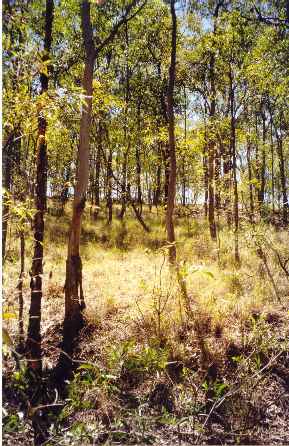
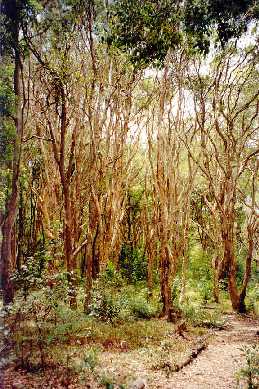
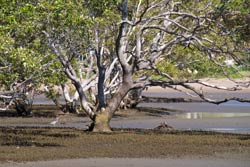
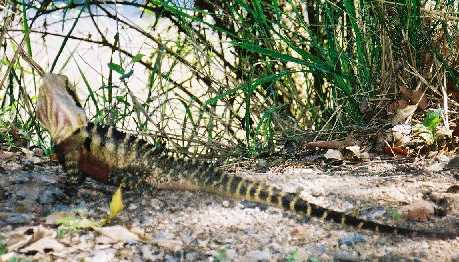 Top
Top